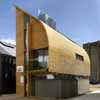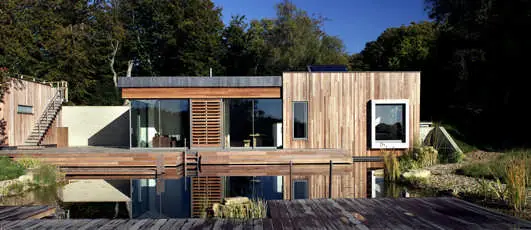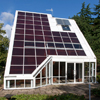Integer House Hertfordshire, BRE Watford Building, Solar PV Glazing , The Smart Home Photos
The Smart Home at BRE Watford
Sustainable English Home, Innovation Park, UK – Transparent Solar PV Glazing by Polysolar
16 Nov 2013
Location: BRE site, Watford, Hertfordshire, southeast England
The Smart Home, Building Research Establishment (BRE) Innovation Park
Back to the Future: Integer House at BRE Watford
Environmental ‘Smart Home’ refurbishment utilises Polysolar’s revolutionary transparent solar PV glazing
Integer House at BRE Watford
The building and construction industry is at last beginning to wake up to the value of building-integrated photovoltaic (BIPV) products. Increasingly, architects, designers and property owners are specifying it as an effective way of including energy micro-generation into the fabric of a building.
Hamish Watson, founder of Polysolar, looks at how the refurbishment of the Integer Millennium House in Watford, first constructed in 1998 and showcased on BBC’s ‘Tomorrow’s World’, has used its innovative transparent photovoltaic glass to prevent excessive thermal gain to the building, while also generating renewable energy.
Intelligent buildings
Integer House, now renamed The Smart Home is located at the Building Research Establishment (BRE) Innovation Park in Watford, it is a three-bedroom demonstration home, first opened in 1998 to showcase world leading innovation in building design, intelligence, environmental performance and construction processes. ‘Tomorrow’s World’ and a six part BBC series named ‘Dream House’ covered the development.
Over 5,000 people have visited Integer Millennium House since its opening and many of the technologies have been adopted into mainstream construction. Over the past 15 years though, building regulations and advances in technology have progressed significantly, so in 2013, British Gas took on the complex refurbishment to bring the building up to date. The vast majority of the UK’s housing stock is more than 15 years old, therefore a refurbishment project represents a more potent and relevant proposition than a new build for its overall effect on meeting reduced carbon emissions and improving the quality of UK housing in the future.
As in the original Integer concept, there were no contracts or budgets, with suppliers donating their materials and expertise free of charge or at cost. BRE and British Gas identified the latest building and environmental technologies from around the world to incorporate in the house.
BIPV: Multi-functional building product The existing glass conservatory, which covered three floors on the south side of the building, was originally intended to provide passive heat gain to the building. This actually resulted in overheating during the day. Also, when Integer House was originally designed, energy costs and CO2 emissions were not key design drivers. Today however, environmental factors such as these, coupled with renewable energy generation requirements of zero carbon building, are primary design tenets, stringently captured in assessment tools such as BRE’s own Environmental Assessment Method (BREEAM).
Polysolar’s innovatively designed transparent and tinted photovoltaic glass acts as a multi-functional substitute for conventional glazing. It delivers an optimal level of shading; a reduction in solar heat gain and glare from the sun; reduced heat loss from the building; as well as generating clean, renewable electricity to power the home.
Thin film technology
Officially opened on October 2nd 2013, the 3.3kW solar PV glass atrium generates, on average, 3,500kWh of electricity per year – enough energy to supply the home’s entire daytime electricity needs and also save 1.8 tons of CO2. This is made possible due to the product’s unique ability to absorb ambient and reflective light on both sides, almost regardless of UK weather conditions. The owners are also eligible for the Government’s Feed-in Tariff, providing an income/saving yield of around £1,130 per year.
The technology within the glass laminate allows it to generate electricity for longer during the day and over the whole year when compared with conventional roof-mounted PV systems, thereby maximising energy generation during sunlight hours. A further benefit for the owners of the Smart Home, is the enhanced growing conditions for plants in the atrium. The PV glass lets through red light required for photosynthesis, therefore the atrium will be ideal for plants as well as providing a pleasant environment in which to sit out in.
The glass was mounted in a conventional aluminium curtain walling system provided by Polysolar’s partners Nationwide Windows and official MCS certified installers, GJH Facades.
Models have demonstrated that excessive heat gain can be reduced by 50% with Polysolar’s PV glass. This then creates a formidable offering when combined with the generation of clean energy and the reduction in heat loss through Polysolar’s ultra low U-value double glazed units.
Product availability, low upfront costings, improved efficiency and output all feed the stringent developments in building regulations, this in turn provides a number of opportunities for the construction industry and architects to take advantage of a truly versatile and innovative multi-purpose 21st Century building material. A building material that not only looks good, but also provides micro-generation capabilities for a wide range of applications including façades, rainscreens, walkway coverings, canopies and roofs.
e. [email protected] | t. 44 (0)1223 911534 | www.polysolar.co.uk
Integer House at BRE Watford images /information from Polysolar
Polysolar
Polysolar is an award-winning technology company, based in Cambridge. The company produces a range of innovative thin-film photovoltaic glazing panels and is developing next generation transparent PV glass windows based on organic polymer PV materials.
Integer House, renamed ‘The Smart Home’ is part of the The Building Research Establishment’ (BRE) Innovation Park in Watford. The house was officially re opened at Insite 2013 on the 2nd October and can be visited by the general public by appointment.
www.bre.co.uk
Polysolar Atrium System
Integer House – BRE Watford 2013
Objective: Waterproof atrium designed to reduce thermal gain and supply the buildings electricity needs.
Solution: Building Integrated PV curtain walling
Size: 3.2kW
Module used: PS-C901 Transparent (90 watts)
Project: The original Building Research Establishment, Integer House was subject of a BBC documentary in 1998 as a public demonstration of new building technologies. Itwas taken over modernised and refurbished by British Gas in 2013 and subsequently renamed the ‘Smart Home.’ Polysolar partnered with Nationwide Windows and GJH facades to supply and install the breathtaking PV glass atrium. Polysolar PS-C-series transparent PV glass was fitted into standard Kawneer aluminium curtain walling to provide the weatherproof atrium envelope.
Result: The PV glass units replaced the conventional glazing, subsequently helping to both reduce the thermal gain to the building and to generate sufficient renewable energy to power the home. Moreover, since the Polysolar Atriumuses standard curtain walling profiles, the integrationof theglass tooknomorethan 2 weeks and resulted in a sleek finish with cabling hidden from view. At the same time the natural amber tint resulted in an amiable environment within the atrium area. Bringing the appropriately certified electrical contractors, Polysolar were able to offer a straight-forward integration along with final certification of the entire system, and 3.4 MWh of electricity per annum.
The sleek aesthetics and low cost of the Polysolar’s PV glazing makes it ideal for a wide variety of applications. This enables customers to showcase CSR and carbon commitments, meet planning and building regulations (BREEAM) and offer the customer an ability to differentiate their design while reducing their building operation costs.
– Reduction in energy consumption
– Aesthetic solution that also limits overheating and excessive sunlight
– Regulation of interior temperature, less need for A/C
– Reduction in CO2 emissions
– Environmental credentials
YouTube video of the home at http://tinyurl.com/kvmtczx
Location: Bucknalls Lane, Watford, England, WD25 9XX, UK
Sustainable Houses England
Zero-carbon home, BRE site, Watford, southeast England
Design: Sheppard Robson with Arup

image from architects
BRE House
English Houses

photo : Nigel Rigden
Related Home Designs
Renewable House made of hemp : BRE Innovation Park
Zero-Carbon Home UK : Barratt Development
English Architecture
English Architecture Design – chronological list
Underhill House, Cotswolds, west England – as featured on Grand Designs
Seymour-Smith Architects

image from architect
Comments or building suggestions / photos for the Integer House at BRE Watford – Sustainable English Property in Hertfordshire England – The Smart Home page welcome


